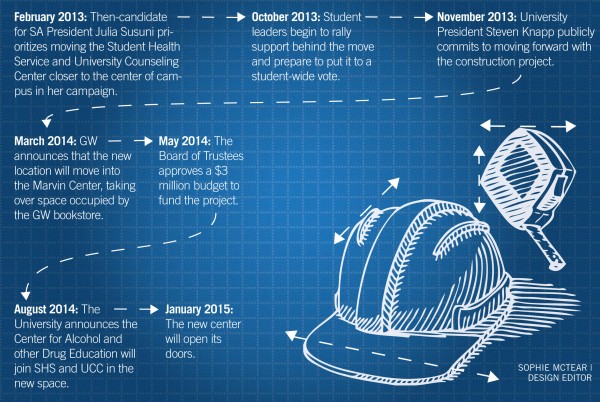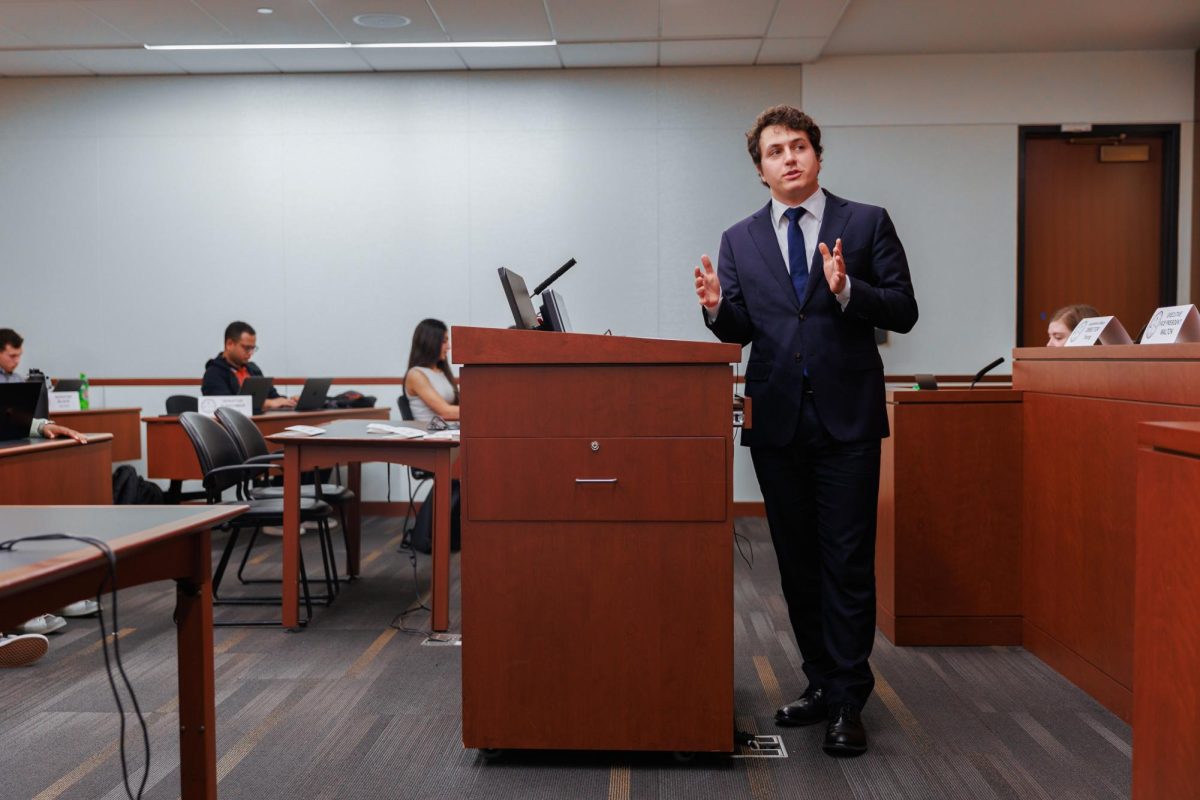Updated: Nov. 10, 2014 at 1:36 p.m.
When officials set out to design GW’s joint health center, they faced a challenging question: How do you mental-health proof a space for both counseling and check-ups?
As they planned to merge the University Counseling Center and Student Health Service, they had to take the stigma surrounding mental illness into consideration, designing the space to ensure students who seek therapy feel like they’re in a safe place.
After months of debate, Dean of Student Affairs Peter Konwerski said the committee tasked with planning the move has decided the centers will be separate in the lower-level Marvin Center space when it opens this spring. The design focuses on waiting-room privacy, Konwerski said.
That will be important for students who seek counseling help for the first time: Officials want to make sure those students don’t feel embarrassed when they say why they’re at the center’s check-in desk. Students who have been seen before will be able to pass through the upper-level waiting room to meet their counselor or doctor.
“Some of the things they are working on is the integration. That’s to be determined,” Konwerski said.
University spokeswoman Maralee Csellar said there are several architectural elements in place to make sure students’ privacy concerns are met. The reception area will include frosted glass wall partitions alongside chairs “to allow staff and students to arrange seating types to personalize waiting areas as needed.”
The center will also have additional insulation, high-performing acoustic ceiling tiles and an integrated white noise system installed in the ceiling to prevent noise from traveling, Csellar said.
Counseling centers are designed to make waiting rooms friendly and inviting, and decorators typically consider wall colors and the amount and type of lighting. Mental health offices also use opaque doors so those outside can’t determine the identity of someone who is seeking help.
Darcy Gruttadaro, the director of the Child & Adolescent Action Center at the National Alliance on Mental Illness, oversees GW’s National Alliance on Mental Illness on Campus student organization. She said when universities merge their health and counseling services, it helps to “normalize mental health in the broader system.”
Once schools decide to combine offices, Gruttadaro said the next step should focus on “commonsense approaches” that allow them to preserve confidentiality. She said training desk workers to be sensitive with the information they handle is most important, and staff should focus on how they sign patients in and whether they have to call names out to the waiting room.
“The school has to take measures to make sure they protect those students. It should be the choice of the students [if they want to disclose information]. It shouldn’t be a policy of whether that choice is considered,” Gruttadaro said.
The centers will have more rooms for appointments and meetings, allowing staff to see more students at once. As demand for counseling services has increased across the nation, students at GW have said they sometimes had to wait weeks to be seen.
The center has added walk-in hours to help free-up appointments for students who needed more immediate attention, and Student Association President Nick Gumas’ peer support program has recently gained traction as another way to supplement the busy center.
The University declined to release the number of counseling sessions for this year, or how long the current wait list is, through University spokesman Kurt Hiatt.

“The numbers of appointments and duration on the wait lists varies. Our services are being used by students and we see students with emergency needs right away,” Hiatt said.
The University committed to renovating the Marvin Center to move UCC and SHS to a centralized location on campus last fall, after former Student Association President Julia Susuni lobbied officials for months to prioritize on-campus counseling.
This fall, GW also announced that the Center for Alcohol and other Drug Education would join the move.
Gumas, who has been a part of talks about the move through the campus mental health committee, said he is satisfied with the way the new space is addressing student privacy.
He pointed out that with one waiting room, no one will know whether a student is waiting for a flu shot or a counseling session.
“No one will know what you’re waiting for when you’re in the waiting room. You don’t say ‘Hi, I’m here for counseling,’ and they slap a sticker on your head,” Gumas said.
Nearly 100 universities across the country have merged their health and counseling centers, according to a 2010 survey by the American College Health Association.
The report notes that those campuses responded positively to the moves, citing increases in “staff communication, quality of clinical services, quality of programs, comprehensiveness of services and programs, client satisfaction, utilization of services and efficiency of administrative processes.”
Before committing to move UCC and SHS closer to the heart of campus, officials cited the centers’ K Street locations as convenient for students looking to stay anonymous. At small schools, anonymity is hard to maintain because most students recognize many of their peers, said Kate Smith, the director of health and counseling services at Reed College.
But GW’s larger campus population can help students maintain their privacy. Smith, who has worked for Reed College for a decade, said a single wellness center allows for a more holistic approach to student health.
She said the doctors and counselors can walk down the hall to confer with each other, and that many do “curbside consultations,” in which a doctor can pop into a counseling session or vice versa to give a patient a quick referral.
“To think that they are really separate concerns is not true. To think of mind and body as two different things is a false dichotomy. You’re part of your body, and your body contains your mind,” Smith said.
A change in location has also been a hot topic for the college: A few years ago, Reed College moved its center from a more centralized location to a larger location that was an extra seven-minute walk from the main buildings on campus. Smith said the first year after the move, they saw a dip in the number of medical visits, though it later bounced back.
“I think it would have been near unanimous that students, faculty and staff would’ve said, ‘I wish it was in the center of campus. A lot of us would still wish for that,” Smith said.
This post was updated to reflect the following clarification:
The Hatchet reported that Darcy Gruttadaro oversees GW’s National Alliance on Mental Illness on Campus program. The post was updated to clarify that she is the director of the Child & Adolescent Action Center at NAMI, who oversees campus chapters across the nation, including GW’s.







